Abstract
As the Smart City concept evolves, it necessarily incorporates more sustainability and inclusiveness features. In this context, the mobility of people is still one of the major challenges for cities. Among the most vulnerable group of citizens are the elderly, as they demand special requirements in the design of smart mobility. At the same time, smart cities’ technologies could be used to maintain their quality of life. From an architectural and sociological point of view, smart cities change the meaning and the use of public spaces, from physical meeting places to relational public spaces, in which humans use interposed technological means and information flows. This leads to the concept of Interconnected Public Spaces: a mixture of physical and virtual environments, generating interconnections at a planetary scale, that can be used to attract elderly people for collectively sharing experiences outdoor in public spaces (parks, squares or bus stops, in any city on our planet), increasing their physical form and stimulating them mentally, socially and emotionally. This paper describes the development of an inclusive smart bus stop prototype and the use of its ICT infrastructure to build Interconnected Public Spaces.
1. Introduction
In the context of Socially Sustainable Cities [1], we certainly have the opportunity to make all city services accessible for everyone. Transportation and mobility systems play a major role in the context of sustainable and inclusive smart cities.
Public transport plays a crucial role for mitigating the social exclusion of vulnerable and disadvantaged groups, affecting their access to basic services and their social and employment relationships. Currently, there are identified specific policies, research priorities and recommendations for local transport, long distance transport and tourism. They address problems such as: (a) the need to combat low awareness of disabled passengers’ rights; (b) lack of information on accessibility of local transport; information presented not in accessible formats or not concise and reliable; (c) low use of mobile apps and social media in the sector; (d) low accessibility in suburban and rural areas; (e) general and major access barriers in interchanges and intermodal hubs [2].
In April 2018, the European Commission published the document “Transport in the European Union. Current Trends and Issues”, which highlights the importance of social aspects in the development of an advanced European transport system: “From a social perspective, affordability, reliability and accessibility of transport are key. However, this has not been achieved across the board. Addressing these challenges will help pursue sustainable growth in the EU” [3].
The scientific literature in relation to the technological systems used in the transportation systems and their main elements is wide [4]. In addition, there is an important volume of scientific literature describing the use of IoT (Internet of Things) [5,6] technologies for improving the quality of life of citizens in smart cities through measures that lead to a healthy, green and sustainable environment.
Social inclusion is a very complex concept. The EU defines social inclusion as a tendency to enable people at risk of poverty or social exclusion to have the opportunity to participate fully in social life, and thus enjoy an adequate standard of living considered normal in the society in which they live [7]. Social inclusion is especially concerned about people or groups of people who are at risk of deprivation, segregation or marginalization. Special attention deserves the situation of women, as some studies reveal that women have different travel patterns from men and that public transportation plays a crucial role in empowerment, access to opportunities and independence [8].
The definition of social exclusion provided in [9] highlights the importance of mobility in modern cities as a key factor in people’s lives, noting that insufficient mobility can cause less accessibility to opportunities, services or social networks.
Therefore, social inclusion and the digitalization of transport have to be harmonized in terms of accessibility, affordability, reliability and inclusiveness, as mentioned in the study about “Social inclusion and EU public transport” [10] for the European Parliament’s Committee on Transport and Tourism.
Among the most vulnerable group of citizens are elderly people, they set special requirements in the design of smart mobility, but at the same time, smart cities’ technologies could be used to maintain or improve their quality of life.
This paper introduces the novel concept of the Interconnected Public Spaces or IP-Spaces: a mixture of physical and virtual environments, that can be used to attract elderly people for collectively sharing experiences outdoor in public spaces (parks, squares or bus stops, in any city on our planet), in order to increase their physical form and stimulate them mentally, socially and emotionally.
A smart bus stop in development will be the first implementation and validation of the IP-Space concept. The stop can attract elderly users, providing an appropriate interface to a modern digitized transport system and opportunistically use the same ICT infrastructure to provide the IP-Space environment.
The paper is structured as follows. Section 2 introduces premises, the novel concept of IP-Spaces, smart bus stop related work, the architecture of the smart bus stop system being developed and the first approach to IP-Space architecture. Section 3 presents current results of this work in progress. Section 4 analyzes how the current implementation can contribute to improve inclusiveness of elder users in the context of smart mobility, providing specific interfaces and features for this sector of population, including IP-Space activities. Finally, Section 5 describes next steps in the development of IP-Spaces as well as other interfaces for smart bus stops that the authors believe can have a big potential impact on inclusiveness and sustainability in smart mobility.
2. Materials and Methods
As shown in Figure 1, elderly people are one of the most vulnerable group of citizens.
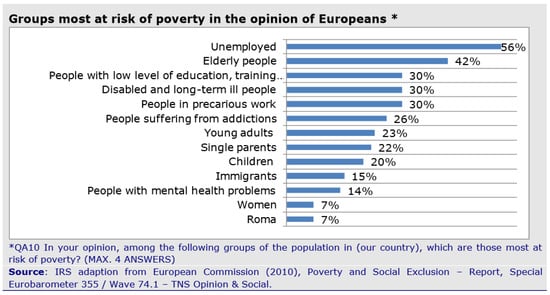
Figure 1.
Vulnerable and disadvantaged groups of citizens.
There were 703 million persons aged 65 years or over in the world in 2019. The number of older persons is estimated to double to 1.5 billion in 2050, growing from the current 9% to 16% of the population [11]. This growing sector of the population have special needs to maintain a good physical and mental wellbeing. These needs include physical exercise, social interaction and mental stimulation. Research into ageing and cognition has demonstrated the close relationship of sensory functioning and social communication to maintaining cognitive performance and mood in the elderly, yet in modern societies elderly people are increasingly isolated and under stimulated, both physically and psychosocially [12,13]. This situation results in accelerated cognitive decline and the suffering associated with loneliness and confusion [12]. Social interaction and intellectual stimulation may be relevant to preserving mental functioning in the elderly [14]. Some studies reports that subjects, who participated in senior citizen clubs or senior centers, can lower risk of cognitive decline, especially if this interaction is realized with young adults [15]. Other studies highlight the potential of video games for the development of physical skills, creating mental and social interactions for elderly people, particularly if these video or computer games are designed with an engaging content and provided through an easy and pleasurable interface [16].
2.1. Elder-Oriented Interconnected Public Space
An “Interconnected Public Space” or IP-Space i.e., an outdoor space provided with ICT equipment that can connect only with a similar space in other part of the world. That means that an IP-Space is a node in a network of IP-Spaces. An IP-Space node can be established in a bus stop, in a park or any other outdoor spot in the city, in which a group of persons could potentially interact with it. Therefore, IP-Spaces allow the sharing of collective experiences.
These nodes can be used to connect with persons from other regions or countries, using the same or different languages. They can be used to participate remotely in different sport, physical, cultural and playful activities (e.g., interesting games or video games, physical exercises, dancing competitions and many more) engaging elderly people in remote communities and stimulating them physically, socially and intellectually.
Promoting participation in cultural and sport activities contributes to emotional, physical health and social cohesion [17]. The positive impact of participation in cultural activities—no matter what the level of ‘artistic competence’ of the people involved—on the perception of one’s own psycho-physic wellbeing has been acknowledged for around 40 years and confirmed by a scientific measurement scale, the psychological general wellbeing index. As a conclusion, the connection between culture and subjective wellbeing may often seem obvious although scientific evidence is much harder to get [18]. Interconnected public spaces can help to create the conditions within which wellbeing seems more likely to increase.
As mentioned before, the implementation of the IP-Space can take place at a smart bus stop.
2.2. Smart Bus Stops
The concept of the smart bus stop is recently new as part of the developments related to Smart Cities [19]. Several European cities have launched smart bus stop pilot projects. That is the case of Paris (one stop, Boulevard Diderot, 85 m2, accessible to persons with disabilities, and providing free Wi-Fi and USB charge, among other services), London (100 Clear Channel bus shelters, using Google Outside service to provide information) and Barcelona (around 10 stops, with mobile-based payment system). Other cities have incorporated some smart elements to traditional stops to supply more information to users, such as arrival time of buses or other general information, without providing more interactivity.
Another example is the smart bus stop prototype of Hungarian company Aquis Innovo in Budapest. The European Commission funded the design and development of the prototype (Figure 2). This prototype, which includes ticket vending, parcel delivery, passenger counting, passenger information, wireless, USB charging, bike rental, air conditioning, taxi ordering, tourist information, news, advertisements, weather forecast, reverse vending, surveillance and other services [20]. On the other hand, there are other smart furniture options, as the outdoor bus ticket-kiosk (Portuguese OEMKIOSK) or information providing smart furniture adapted to people with disabilities such as the Portuguese TOMI as shown in Figure 3.
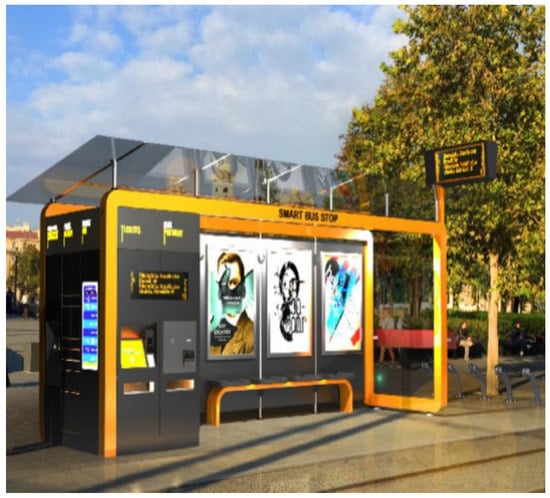
Figure 2.
Aquis Innovo’s Smart-Stop (https://europa.eu/investeu/projects/smart-bus-stop_es.EUInvest).
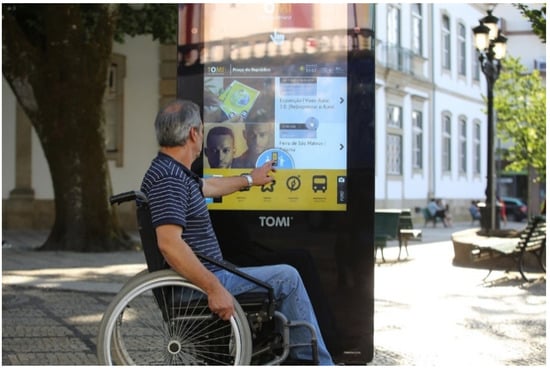
Figure 3.
Outdoor TOMI accessible information kiosk (Courtesy TOMI World).
Another example of an advanced pilot project regarding Smart-Stop is the case of Aizuwakamatsu city, Japan. There, the low consumption, bistable e-paper (only consumes power when the message changes) is solar powered and communicated with low power wide area (LPWA) wireless technology to provide information to users. This allows replacing paper timetables and improving the user experience. Managed remotely through the Papercast data management platform, the multilingual displays will present live bus arrivals, timetables, route data, route transfers, service alterations (planned and unplanned) and a range of other travel advices [21].
Despite the huge potential of smart bus stops, their penetration in many European cities is very limited and its adaptation to inclusiveness is just starting to be developed.
2.3. MUSA Smart Bus Stop
MUSA (Advanced Sustainable Urban Furniture–Mobiliario Urbano Sostenible y Avanzado) is the smart bus stop under development in the city of Madrid that will also host an IP-Space. Its main characteristic is the provision of information services with a focus on inclusive and socially-driven transport aspects.
The smart bus stop, from the inclusiveness point of view, is:
- a)
- An interactive bus stop available to the whole population. It is a public access point to a digitized transport system (DTS), which allows access to persons without apps or even without a smart phone.
- b)
- It can work as a public access point and as a travel assistant for low-income or disadvantaged groups of users.
- c)
- It can improve the accessibility to DTS through customization of interfaces and reduction of cognitive demand.
- d)
- It can improve planning in real-time taking into account unexpected events that can improve or disrupt transport operations.
- e)
- Through an attractive and customized interface, it can foster the penetration of travel planning apps and its use by different user groups (elders, immigrants, etc.).
- f)
- It can be implemented as a reduced size smart furniture providing a robust, essential electronic equipment that converts traditional stops into accessible smart bus stops, minimizing the modernization cost and having a wide use in the cities and rural areas.
- g)
- Finally, it can be used for introducing Interconnected Public Space spots of the city. This is very suitable when the smart bus stop is in a park or square, where people can be involved in sport, physical and cultural activities. Sharing the same ICT infrastructure makes the system attractive from an aesthetical and economic point of view.
2.3.1. MUSA Smart Bus Stop System Architecture
MUSA is a physical stop equipped with an interactive display (currently a 40-inch monitor provided with an infrared frame) and a computer system communicating with a set of cloud systems to provide different services to travelers at the stop. These services available in the stop are called Group Services (Figure 4).
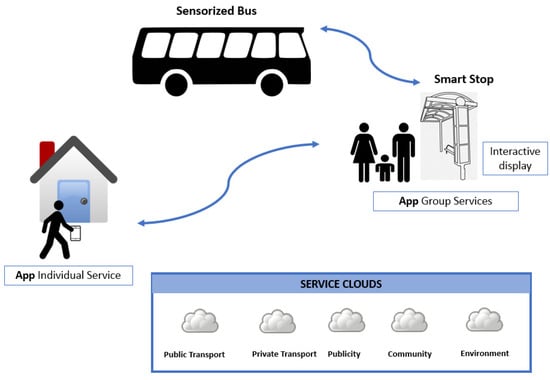
Figure 4.
Main components of MUSA system architecture.
The main point of these services is a multimodal travel planner including options for walking, cycling, private and public transport. The interface to this urban equipment is being customized to increase the accessibility for all citizens and particularly for those vulnerable to exclusion.
In addition, a community service is available for planning and realization of IP-Space related activities. Services related to publicity, environment and health are also planned, without excluding others that can be included in the future.
Transport services and applications provided in the stop can also be available for mobile phones. These apps are called Individual Services (Figure 4). Some of these apps are currently implemented using web technologies and accessing third parties’ services through their APIs. Other apps, still under development, will use our own developed cloud-based services. Through the use of Individual Services, the smart bus stop can help to foster transport planning in general, not only when passengers are waiting in the stop, but also in any other places using mobile phones or other devices. A massive planning of transport needs can help to develop new ways of organizing transport [22].
The planning of users’ transport needs helps to characterize the demand on transport systems. This identified demand jointly with sensorization of transport means can be used by transport providers to customize and fine-tune their services in order to meet user requirements (Figure 5) and increase satisfaction of their clients.
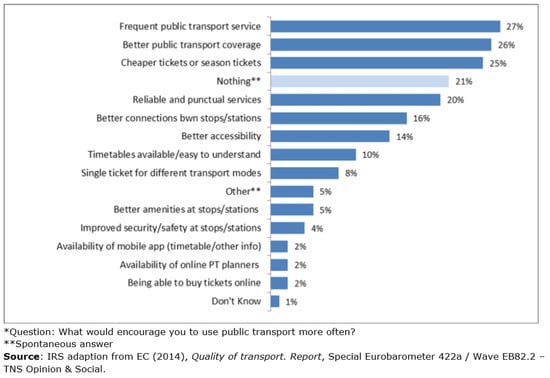
Figure 5.
Factors that can encourage the use of public transport (Roma refers to Romani people).
A key factor in the users’ transport planning is to know or estimate real-time bus occupancy. Otherwise, this planning can be useless. This factor is taken into account in MUSA system.
2.3.2. Sensorization of Buses
The efficiency of planning, from users’ as well as from transport providers’ point of view, is highly correlated to the level of sensorization of transport means. In the context of MUSA project, this led to increased sensorization of buses installing Automatic Passenger Counters (APC) to know the occupancy of the bus in real-time, the availability of free places for wheelchairs and baby strollers, as well as the flow of passengers in each bus stop [22,23].
The use of APC for transport providers is very important to analyze the performance of bus services in real-time, to detect the most demanded routes or segment of routes and potentially replan them to increase efficiency of service and users’ satisfaction. From users’ point of view, the bus occupancy (or its probability) is crucial for effective planning (it is useless, if the planned bus comes full and passengers cannot get on board).
Buses normally include AVL (Automatic Vehicle Location) using GPS and SC-AFC (Smart Card Automatic Fare). For a flat rate service (where passengers do not check out when alighting the bus, as in Madrid), the next level of sensorization was the use of APC or Automatic Passenger Counters. There are different technologies for APC, for example, infrared systems and vision systems (video cameras, stereo cameras and time-of-flight cameras).
The use of the latter can be adapted to detect free available places for wheelchairs and baby strollers, thereby supporting greater inclusiveness.
Though for this project, infrared systems and stereo cameras were studied, MUSA used simple video CCTV cameras from Retail Sensing, a Manchester company, and evaluated their performance in real-life conditions (Figure 6). The cameras, located on top of the front and rear doors, use artificial vision algorithms to count in and out passengers. This information was sent through a 4G router to an MQTT server to make it globally available.
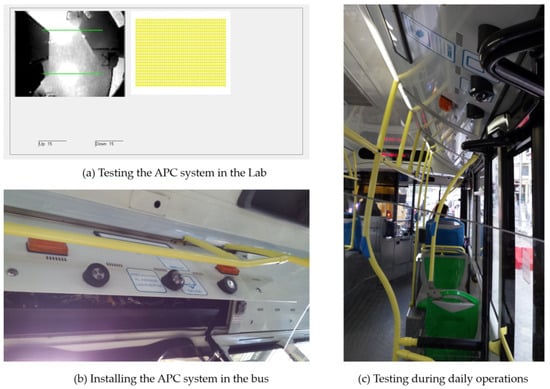
Figure 6.
Installing and testing the Automatic Passenger Counters (APC) based on video cameras.
First, we tested the camera system in the Lab; next, we installed it inside a bus and tested it during daily operations in the center of Madrid (Figure 7 and Figure 8).
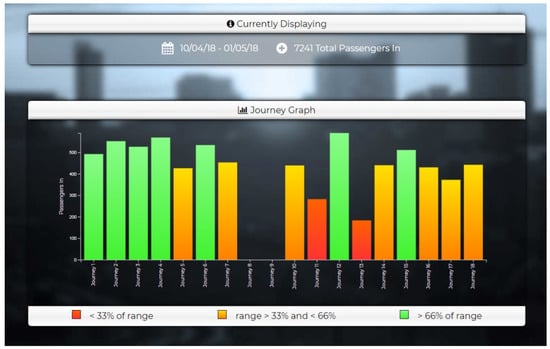
Figure 7.
Number of daily passengers entering the bus (Courtesy Retail Sensing).
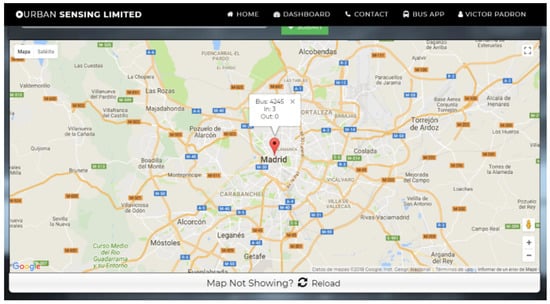
Figure 8.
Behavior of passengers’ flow at one bus stop (Courtesy Retail Sensing).
Currently, a massive installation of APC systems using time-of-flight and Artificial Intelligence systems is taking place on Madrid buses. It is foreseeable that information about real-time occupancy of buses and availability of wheelchairs and baby strollers will be publicly available as Open Data.
2.3.3. MUSA Transport Services
The multimodal trip planner employed in MUSA includes options for walking, cycling, private and public transport. It is designed as a special software layer (Figure 9) that can run on a commercial travel planner, such as Google Maps (and its API). This approach has three advantages: it allows the customization of interfaces for different users’ segments; as elderly people, it allows the anonymous collection of traveling data for building mobility models and developing social innovation solutions (Social Model in Figure 9); and finally, it can be adapted to different commercial planners.

Figure 9.
Layering of the multimodal planning application.
2.3.4. Interconnected Public Space Service in MUSA
The new functionality of the Interconnected Public Space (IP-Space) is being developed in the current prototype of a MUSA smart bus stop.
From the stop, which is an IP-Space node, a user or set of users can connect to persons from other regions or countries present in another IP-Space node, using the same or different languages. All can participate remotely in different sport, physical, cultural and playful activities (e.g., interesting games or video games, physical exercises, dancing competitions and many more). The interface can transmit audio or video using cameras and microphones, although this can be restricted in accordance with current local privacy laws. This also will depend on whether the IP-Space is physically enclosed or if it is a completely open public location. However, in all cases, the interface will allow the transmission of images, graphics and text as basic means of communication.
In a first approach to the design of the prototype, the high-level operation of this service consists of three steps (Figure 10):

Figure 10.
IP-Space users’ interaction sequence.
- a)
- Map. In this step, users request the realization of a given activity to other people in a remote IP-Space. They can agree to start the activity immediately or schedule it at a given date and time.
- b)
- Menu. They select the desired or scheduled activity from the repository and access it.
- c)
- Activity. They proceed to realize the desired activity. They will have a language assistance application, so people from different countries and culture can communicate.
3. Results
The current state of the prototype of the MUSA smart bus stop and its main interface are shown in Figure 11. An advertisement is running in the background (in this case, for musicals in the center of Madrid), while different services are available in the lower carrousel. For intuitively attracting users to different interfaces, two type of icons are available. A traditional picture is used to attract more resolute and direct users (e.g., some senior people). Let us call it the “conservative interface”. Moreover, a more playful icon is used to attract more skillful and playful users (e.g., some junior or young people). Let us call this the “playful interface”. Other future special services for assisting travelers with special needs (elderly, those with reduced mobility, easier travel with kids or pregnant women) are also included in the interface.
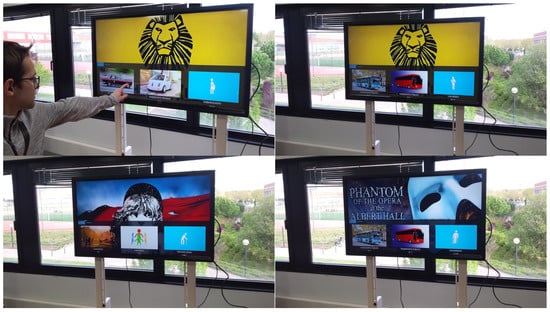
Figure 11.
Main interface of the smart bus stop prototype.
The conservative interface of the public transport app is shown in Figure 12. A box with the most frequently used destination from the current stop is shown in the top right corner. This helps to increase the probabilities of reducing the interaction to minimum. Below, a box shows time and duration of the selected trip. In addition, there is an option to select private or other type of alternative transport without leaving the conservative mode of interaction.
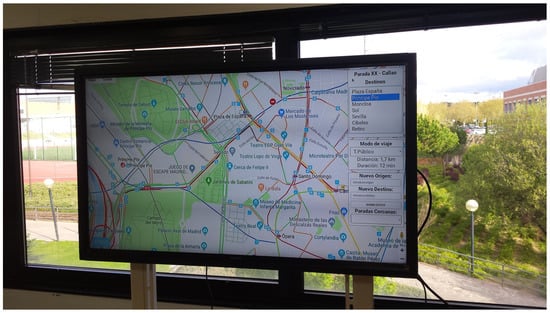
Figure 12.
Multimodal planner using public transport.
A third box allows users to select any origin and destination, using a tactile keyboard on the screen. Destinations are dynamically ordered based on their frequency of use. That means that the stop system can learn from users’ interactions the required destinations at each time of the day during the week.
Finally, information about nearest bus stops can be searched. Typical interactive features of Google Maps are disabled, so conservative users cannot be distracted from their simple, direct interaction with the app.
Figure 13 shows the conservative interface for fostering physical exercises by means of walking. In this case, time and duration of a trip walking and using public transport are similar, so the option of walking can be healthier for the user. This feature can be very interesting for elderly people.
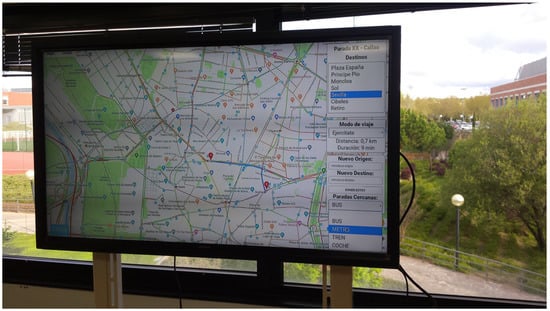
Figure 13.
Fostering physical exercise.
Another interesting service for elderly people (under development) is the possibility to use mobility service providers as Uber, Cabify or Free Now, without having the application or even having a smartphone (Figure 14). The private transport interface of the MUSA smart bus stop can check the availability of these services and order a trip using a dedicated account. The user will pay using cash, as this payment option is currently available in big cities.
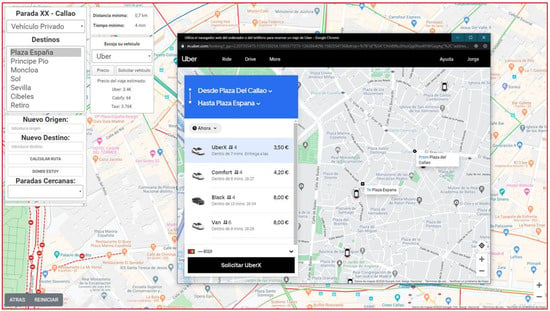
Figure 14.
Ordering a mobility service from the smart bus stop.
The main interface design of the IP-Space is shown in Figure 15. Again, there are two icons for conservative and playful interfaces, labelled as “Community”, which give access to IP-Space services. A third icon is reserved for future services to the elderly.
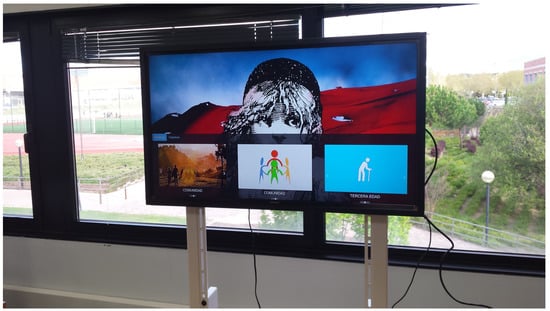
Figure 15.
Interconnected public space access interface.
4. Discussion
This work in progress is an experimental platform, which has two main objectives: increasing social inclusiveness and quality of life of the elderly.
First, it addresses the inclusiveness in general, and especially of elderly people in smart transport systems (digitized transport systems). For the elderly, a customization of interfaces is proposed to reduce cognitive demand in the use of a multimodal transport planner application. The use of an easy interface can foster that users employ the same apps available in the MUSA stop (Group Services) in their mobile phones (Individual Services).
Sensorizing buses to detect or estimate buses’ real-time occupancy is crucial for increasing the effectiveness of transport planning, from both users’ and transport providers’ points of view. The use of sensors as time-of-flight cameras for this task can be used to detect or estimate vacant places for wheelchairs and baby strollers, therefore increasing inclusiveness.
Therefore, this work is addressing several issues related to inclusiveness as the lack of information on accessibility of local transport, the lack of information presented in accessible formats or concise and reliable, and the low use of mobile apps and social media in the local transport sector.
Increasing the use of planning apps have the potential to anonymously create mathematical models for planning mobility at city scale and therefore, opens the possibility of new transportation paradigms. In addition, socialization at smart bus stops allows citizens to potentially organize and require new transport options.
Other features providing for elderly users are the fostering of walking (physical exercise) and the chance to friendly order mobility services as Uber, Cabify, FreeNow, etc., increasing their trust on these new transport options.
Finally, this paper introduces the novel concept of Interconnected Public Space or IP-Space and describe its potential for increasing (or at least maintain) quality of life of the elderly. Basic design of IP-Space is described, as well as how to link it with smart bus stop development, to take advantage of ICT smart bus stop infrastructure. This can be particularly effective in wide outdoor spaces as parks and squares, producing a faster and cheaper deployment of IP-Spaces.
5. Conclusions
Interconnected Public Spaces are in a very early stage of development and sociological research; there are several lines of research to explore as soon as the prototype will be ready. It will need to address sociological and psychological acceptance, legal issues in different countries, the development of the activities, the physical construction of the IP-Spaces from an architectural point of view, etc.
Regarding the smart bus stop, the next step in research is the study of more advanced interfaces, as those provided by the Voice Activated Personal Assistants or VAPA (e.g., Alexa), taking into account privacy concerns [24] and cybersecurity. This can require the design of a physical interface in the smart furniture, creating a micro space that isolates users and makes easier voice interaction. This type of interface can also help to foster the use of VAPAs at home. Furthermore, VAPA systems have the potential to increase accessibility of disabled people in general [25] and the elderly [26], as well as decrease the cognitive load and the effort of planning travels in the context of modern digitized transport systems. Finally, there are technical and research challenges related to the performance of VAPA systems outdoors with multiple voices and the improving of voice interface for elderly people [27].
Author Contributions
Conceptualization and Methodology, V.M.P.N., D.G.P., O.G.P. and J.L.E.P.; Software design, V.M.P.N., M.J.G.S. and O.G.P.; Investigation, M.J.G.S., D.G.P., J.L.E.P., V.M.P.N., O.G.P. and F.M.d.P.; writing—review and editing, V.M.P.N., D.G.P. and J.L.E.P. All authors have read and agreed to the published version of the manuscript.
Funding
This research was funded by Universidad Europea de Madrid by grants numbered 2017/UEM22, 2018/UEM06 and 2019/UEM19.
Acknowledgments
We want to express our deep gratitude to all those persons and institutions that are helping and supporting us in the realization of this project. We want to thank the institutional support from the Municipal Transport Company (EMT) of Madrid, for the kind support of its executives and technical staff; Asad Syed from Retail Sensing for his kind support and sponsorship with the APC system; and our students, Alba Gutiérrez García-Ochoa, Alfonso López Pérez, Germán García García and Jorge García González. To all of you, thank you very much.
Conflicts of Interest
The authors declare no conflict of interest. All trademarks are the property of their respective owners.
References
- Verebes, T. (Ed.) Masterplanning the Adaptive City: Computational Urbanism in the Twenty-First Century, 1st ed.; Routledge, Taylor and Francis Group: London, UK; New York, NY, USA, 2014. [Google Scholar]
- Bekiaris, E.; Loukea, M.; Spanidis, P.; Ewing, S.; Denninghaus, M.; Ambrose, I.; Papamichail, K.; Castiglioni, R.; Veitch, C. Research for TRAN Committee: Transport and Tourism for Persons with Disabilities and Persons with Reduced Mobility; European Parliament, Policy Department for Structural and Cohesion Policies: Brussels, Belgium, 2018; p. 19.
- Transport in the European Union: Current Trends and Issues. Available online: https://ec.europa.eu/transport/sites/transport/files/2018-transport-in-the-eu-current-trends-and-issues.pdf (accessed on 25 April 2020).
- Kehua, S.; Jie, L.; Hongbo, F. Smart city and the applications. In Proceedings of the International Conference on Electronics, Communications and Control (ICECC), Ningbo, China, 9–11 September 2011; pp. 1028–1031. [Google Scholar]
- Mohanty, S.P.; Choppali, U.; Kougianos, E. Everything you wanted to know about smart cities: The Internet of things is the backbone. IEEE Consum. Electron. Mag. 2016, 5, 60–70. [Google Scholar] [CrossRef]
- Cisco España. Internet of Things World Forum Barcelona 2013 (Video, November 2013). Wallbank, P. Touring the Barcelona Smart City Project. Available online: http://paulwallbank.com/2014/06/09/geeks-tour-of-smartcity-barcelona-slideshow-cisco-iot/ (accessed on 27 March 2020).
- Poverty and Social Exclusion. Available online: https://ec.europa.eu/social/main.jsp?catId=751&langId=en (accessed on 24 April 2020).
- The Role of Women in the Green Economy. The Issue of Mobility. Available online: http://www.europarl.europa.eu/RegData/etudes/note/join/2012/462453/IPOL-FEMM_NT(2012)462453_EN.pdf (accessed on 24 April 2020).
- Kenyon, K.; Lyons, G.; Rafferty, J. Transport and social exclusion: Investigating the possibility of promoting social inclusion through virtual mobility. J. Transp. Geogr. 2003, 10, 207–219. [Google Scholar] [CrossRef]
- Social Inclusion in EU Public Transport. Available online: https://www.europarl.europa.eu/RegData/etudes/STUD/2015/540351/IPOL_STU(2015)540351_EN.pdf (accessed on 24 April 2020).
- Department of Economic and Social Affairs, United Nations. World Population Ageing 2019: Highlights; United Nations: New York, NY, USA, 2019; pp. 1–2. [Google Scholar]
- Waterworth, J.; Ballesteros, S.; Christian, P.; Bieber, G.; Kreiner, A.; Wiratanaya, A.; Polymenakos, L.; Wanche-Politis, S.; Capobianco, M.; Etxeberria, I.; et al. Ageing in a networked society—Social inclusion and mental stimulation. In Proceedings of the 2nd International Conference on Pervasive Technologies Related to Assistive Environments (PETRA 2009), Corfu, Greece, 9–13 June 2009. [Google Scholar]
- Rabbitt, P. Cognitive changes across the lifespan. In The Cambridge Handbook of Age and Ageing, 1st ed.; Johnose, M.L., Bengston, V.L., Coleman, P.G., Kirkwood, T.B.L., Eds.; Cambridge University Press: Cambridge, UK, 2005; pp. 190–199. [Google Scholar]
- Wang, H.; Karp, A.; Winblad, B.; Fratiglioni, L. Late-Life Engagement in Social and Leisure Activities Is Associated with a Decreased Risk of Dementia: A Longitudinal Study from the Kungsholmen Project. Am. J. Epidemiol. 2002, 155, 1081–1087. [Google Scholar] [CrossRef] [PubMed]
- Lee, S.H.; Kim, Y.B. Which type of social activities may reduce cognitive decline in the elderly?: A longitudinal population-based study. BMC Geriatr. 2016, 16, 165. [Google Scholar] [CrossRef] [PubMed]
- IJsselsteijn, W.; Nap, H.H.; de Kort, Y.; Poels, K. Digital Game Design for Elderly Users. In Proceedings of the Conference on Future Play—Future Play ’07, Toronto, ON, Canada, 15–17 November 2007. [Google Scholar]
- Brophy, M.; Mguni, N.; Mulgan, G.; Shandro, A. The State of Happiness: Can Public Policy Shape People’s Wellbeing and Resilience? The Young Foundation: London, UK, 2010; Available online: https://youngfoundation.org/wp-content/uploads/2012/10/The-State-of-Happiness.pdf (accessed on 22 April 2020).
- Diener, E. The Science of Well-Being: The Collected Works of Ed Diener; Social Indicators Research Series; Springer: London, UK, 2009; Volume 37. [Google Scholar]
- Gretzel, U.; Sigala, M.; Xiang, Z.; Koo, C. Smart tourism: Foundations and developments. Electron. Mark. 2015, 25, 179–188. [Google Scholar] [CrossRef]
- Aquis Innovo. Available online: https://europa.eu/investeu/projects/smart-bus-stop_es (accessed on 22 April 2020).
- Papercast 2018. Available online: https://www.papercast.com/epaper_bus_stop_passenger_information_solutions/products_e-paper_displays/ (accessed on 22 April 2020).
- Nápoles, V.M.P.; Rodríguez, M.B.; Páez, D.G.; Penelas, J.L.E.; García-Ochoa, A.G.; Pérez, A.L. MUSA–I. Towards New Social Tools for Advanced Multi-Modal Transportation in Smart Cities. Proceedings 2018, 2, 1215. [Google Scholar]
- Nápoles, V.M.P.; Páez, D.G.; Penelas, J.L.E.; García, G.G.; Santacruz, M.J.G. Bus Stops as a Tool for Increasing Social Inclusiveness in Smart Cities. In Smart Cities. ICSC-CITIES 2019. Communications in Computer and Information Science, 1st ed.; Nesmachnow, S., Hernández Callejo, L., Eds.; Springer: Cham, Switzerland, 2020; Volume 1152, pp. 215–227. [Google Scholar]
- Moorthy, A.E.; Vu, K.L.V. Privacy Concerns for Use of Voice Activated Personal Assistant in the Public Space. Int. J. Hum. Comput. Interact. 2015, 31, 307–335. [Google Scholar] [CrossRef]
- Pradhan, A.; Mehta, K.; Findlater, L. “Accessibility Came by Accident”: Use of Voice-Controlled Intelligent Personal Assistants by People with Disabilities. In Proceedings of the 2018 CHI Conference on Human Factors in Computing Systems, Montreal, QC, Canada, 21–26 April 2018; pp. 1–13. [Google Scholar]
- O’Brien, K.; Liggett, A.; Ramirez-Zohfeld, V.; Sunkara, P.; Lindquist, L.A. Voice-Controlled Intelligent Personal Assistants to Support Aging in Place. J. Am. Geriatr. Soc. 2020, 68, 176–179. [Google Scholar]
- Sayago, S.; Neves, B.B.; Cowan, B.R. Voice assistants and older people: Some open issues. In Proceedings of the 1st International Conference on Conversational User Interfaces, Dublin, Ireland, 22–23 August 2019; pp. 1–3. [Google Scholar]
© 2020 by the authors. Licensee MDPI, Basel, Switzerland. This article is an open access article distributed under the terms and conditions of the Creative Commons Attribution (CC BY) license (http://creativecommons.org/licenses/by/4.0/).